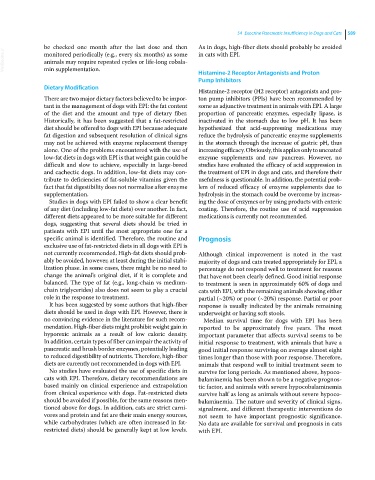Page 621 - Clinical Small Animal Internal Medicine
P. 621
54 Exocrine Pancreatic Insufficiency in Dogs and Cats 589
be checked one month after the last dose and then As in dogs, high‐fiber diets should probably be avoided
VetBooks.ir monitored periodically (e.g., every six months) as some in cats with EPI.
animals may require repeated cycles or life‐long cobala-
min supplementation.
Histamine‐2 Receptor Antagonists and Proton
Pump Inhibitors
Dietary Modification
Histamine‐2 receptor (H2 receptor) antagonists and pro-
There are two major dietary factors believed to be impor- ton pump inhibitors (PPIs) have been recommended by
tant in the management of dogs with EPI: the fat content some as adjunctive treatment in animals with EPI. A large
of the diet and the amount and type of dietary fiber. proportion of pancreatic enzymes, especially lipase, is
Historically, it has been suggested that a fat‐restricted inactivated in the stomach due to low pH. It has been
diet should be offered to dogs with EPI because adequate hypothesized that acid‐suppressing medications may
fat digestion and subsequent resolution of clinical signs reduce the hydrolysis of pancreatic enzyme supplements
may not be achieved with enzyme replacement therapy in the stomach through the increase of gastric pH, thus
alone. One of the problems encountered with the use of increasing efficacy. Obviously, this applies only to uncoated
low‐fat diets in dogs with EPI is that weight gain could be enzyme supplements and raw pancreas. However, no
difficult and slow to achieve, especially in large‐breed studies have evaluated the efficacy of acid suppression in
and cachectic dogs. In addition, low‐fat diets may con- the treatment of EPI in dogs and cats, and therefore their
tribute to deficiencies of fat‐soluble vitamins given the usefulness is questionable. In addition, the potential prob-
fact that fat digestibility does not normalize after enzyme lem of reduced efficacy of enzyme supplements due to
supplementation. hydrolysis in the stomach could be overcome by increas-
Studies in dogs with EPI failed to show a clear benefit ing the dose of enzymes or by using products with enteric
of any diet (including low‐fat diets) over another. In fact, coating. Therefore, the routine use of acid suppression
different diets appeared to be more suitable for different medications is currently not recommended.
dogs, suggesting that several diets should be tried in
patients with EPI until the most appropriate one for a
specific animal is identified. Therefore, the routine and Prognosis
exclusive use of fat‐restricted diets in all dogs with EPI is
not currently recommended. High‐fat diets should prob- Although clinical improvement is noted in the vast
ably be avoided, however, at least during the initial stabi- majority of dogs and cats treated appropriately for EPI, a
lization phase. In some cases, there might be no need to percentage do not respond well to treatment for reasons
change the animal’s original diet, if it is complete and that have not been clearly defined. Good initial response
balanced. The type of fat (e.g., long‐chain vs medium‐ to treatment is seen in approximately 60% of dogs and
chain triglycerides) also does not seem to play a crucial cats with EPI, with the remaining animals showing either
role in the response to treatment. partial (~20%) or poor (~20%) response. Partial or poor
It has been suggested by some authors that high‐fiber response is usually indicated by the animals remaining
diets should be used in dogs with EPI. However, there is underweight or having soft stools.
no convincing evidence in the literature for such recom- Median survival time for dogs with EPI has been
mendation. High‐fiber diets might prohibit weight gain in reported to be approximately five years. The most
hyporexic animals as a result of low caloric density. important parameter that affects survival seems to be
In addition, certain types of fiber can impair the activity of initial response to treatment, with animals that have a
pancreatic and brush border enzymes, potentially leading good initial response surviving on average almost eight
to reduced digestibility of nutrients. Therefore, high‐fiber times longer than those with poor response. Therefore,
diets are currently not recommended in dogs with EPI. animals that respond well to initial treatment seem to
No studies have evaluated the use of specific diets in survive for long periods. As mentioned above, hypoco-
cats with EPI. Therefore, dietary recommendations are balaminemia has been shown to be a negative prognos-
based mainly on clinical experience and extrapolation tic factor, and animals with severe hypocobalaminemia
from clinical experience with dogs. Fat‐restricted diets survive half as long as animals without severe hypoco-
should be avoided if possible, for the same reasons men- balaminemia. The nature and severity of clinical signs,
tioned above for dogs. In addition, cats are strict carni- signalment, and different therapeutic interventions do
vores and protein and fat are their main energy sources, not seem to have important prognostic significance.
while carbohydrates (which are often increased in fat‐ No data are available for survival and prognosis in cats
restricted diets) should be generally kept at low levels. with EPI.

